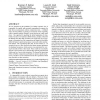Free Online Productivity Tools
i2Speak
i2Symbol
i2OCR
iTex2Img
iWeb2Print
iWeb2Shot
i2Type
iPdf2Split
iPdf2Merge
i2Bopomofo
i2Arabic
i2Style
i2Image
i2PDF
iLatex2Rtf
Sci2ools
HRI
2006
ACM
2006
ACM
Attaining situational awareness for sliding autonomy
We are interested in the problems of a human operator who is responsible for rapidly and accurately responding to requests for help from an autonomous robotic construction team. A difficult aspect of this problem is gaining an awareness of the requesting robot’s situation quickly enough to avoid slowing the whole team down. One approach to speeding the initial acquisition of situational awareness is to maintain a buffer of data, and play it back for the human when their help is needed. We report here on an experiment to determine how the composition and length of this buffer affect the human’s speed and accuracy in our multi-robot construction domain. The experiments show that, for our scenario, 5 - 10 seconds of one raw video feed led to the fastest operator attainment of situational awareness, while accuracy was maximized by viewing 10 seconds of three video feeds. These results are necessarily specific to our scenario, but we feel that they indicate general trends which may b...
Autonomous Robotic Construction | HRI 2006 | Human Robot Interaction | Situational Awareness | Video Feeds |
| Added | 13 Jun 2010 |
| Updated | 13 Jun 2010 |
| Type | Conference |
| Year | 2006 |
| Where | HRI |
| Authors | Brennan Sellner, Laura M. Hiatt, Reid G. Simmons, Sanjiv Singh |
Comments (0)

